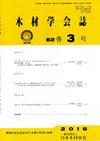The Effects of Veneer Selection by Radial Location in Logs on Strength Properties of LVL in Japanese Larch (Larix kaempferi) Planted in Hokkaido
IF 0.1
4区 农林科学
Q4 MATERIALS SCIENCE, PAPER & WOOD
引用次数: 0
Abstract
The aim of this study was to examine the effect of the radial location of veneer on the strength properties of laminated veneer lumber (LVL) in Japanese larch grown in Hokkaido. We manufactured LVL using veneers taken from different radial locations in logs, and then examined their strength properties using bending and horizontal shear tests. In addition, we examined how annual ring width of the logs influences the modulus of elasticity of both the logs and the veneers. Our results suggested that there was a significant negative correlation (p < 0.01) between the average annual ring width and the modulus of elasticity of the logs. The modulus of elasticity of veneers (EV) increased as distance from the center of the veneer lathe spindle increased, and average EV was higher for logs with lower average annual ring width. In addition, we compared the strength properties of LVL composed of veneers sourced from the outer part of logs (>12 cm from the center of the veneer lathe spindle) with that sourced from the inner part of logs (<10 cm from the center of the veneer lathe spindle). LVL composed of the outer veneers was stronger than that composed of the inner veneers; 53% higher in modulus of elasticity, 65% higher in bending strength, and 26% higher in nominal shear strength. These results indicate that veneer sorting by radial location in logs is effective.木材径向定位选择贴面对北海道日本落叶松LVL强度特性的影响
本研究的目的是研究饰面径向位置对北海道落叶松单板层压木材强度特性的影响。我们使用从测井曲线的不同径向位置取下的贴片制作LVL,然后通过弯曲和水平剪切测试检测其强度特性。此外,我们研究了原木年轮宽度如何影响原木和单板的弹性模量。结果表明,年轮平均宽度与原木弹性模量呈显著负相关(p < 0.01)。单板弹性模量(EV)随着离单板车床主轴中心距离的增加而增加,且平均年轮宽越小,平均EV越高。此外,我们还比较了原木外部(距单板车床主轴中心约12cm)和原木内部(距单板车床主轴中心< 10cm)的单板组成的LVL的强度特性。由外贴面组成的LVL比由内贴面组成的LVL更强;弹性模量提高53%,抗弯强度提高65%,公称抗剪强度提高26%。这些结果表明,利用测井曲线的径向位置对单板进行分选是有效的。
本文章由计算机程序翻译,如有差异,请以英文原文为准。
求助全文
约1分钟内获得全文
求助全文

 求助内容:
求助内容: 应助结果提醒方式:
应助结果提醒方式:


